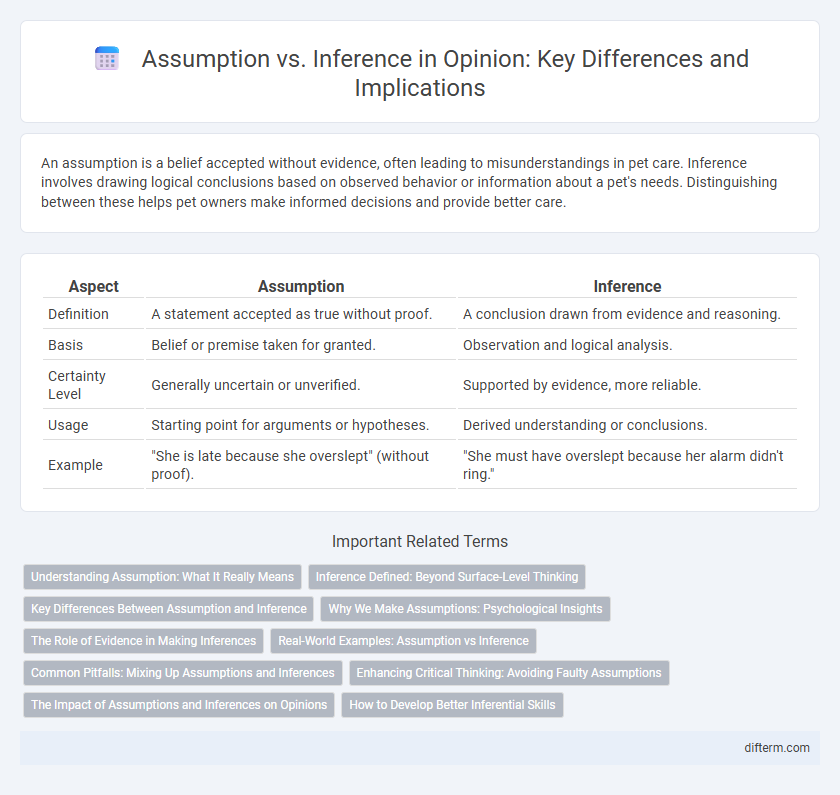An assumption is a belief accepted without evidence, often leading to misunderstandings in pet care. Inference involves drawing logical conclusions based on observed behavior or information about a pet's needs. Distinguishing between these helps pet owners make informed decisions and provide better care.
Table of Comparison
| Aspect | Assumption | Inference |
|---|---|---|
| Definition | A statement accepted as true without proof. | A conclusion drawn from evidence and reasoning. |
| Basis | Belief or premise taken for granted. | Observation and logical analysis. |
| Certainty Level | Generally uncertain or unverified. | Supported by evidence, more reliable. |
| Usage | Starting point for arguments or hypotheses. | Derived understanding or conclusions. |
| Example | "She is late because she overslept" (without proof). | "She must have overslept because her alarm didn't ring." |
Understanding Assumption: What It Really Means
Understanding assumption involves recognizing it as a foundational belief accepted without direct evidence, often shaping how information is interpreted. Assumptions serve as the implicit starting points for reasoning, distinguishing them from inferences, which are conclusions drawn from evidence and logical thinking. Grasping this distinction enhances critical thinking by clarifying how unexamined beliefs influence perception and decision-making.
Inference Defined: Beyond Surface-Level Thinking
Inference involves drawing logical conclusions from available evidence, surpassing mere assumption based on incomplete information. It requires critical analysis and synthesis of observed facts to form reasoned judgments. Unlike assumptions, inferences are grounded in evidence and logical reasoning, enhancing the depth of understanding in decision-making processes.
Key Differences Between Assumption and Inference
Assumptions are beliefs accepted without evidence, serving as the foundation for reasoning, while inferences are logical conclusions drawn from available information. Assumptions often involve guessing or hypothesizing, whereas inferences rely on analyzing data or observations. Understanding the distinction between these concepts is crucial for critical thinking and effective decision-making.
Why We Make Assumptions: Psychological Insights
Humans make assumptions as cognitive shortcuts to efficiently process complex information and reduce uncertainty in decision-making. Psychological research highlights that assumptions often stem from heuristics shaped by past experiences and social conditioning. While assumptions facilitate quick judgments, they can also lead to biases, underscoring the importance of distinguishing them from evidence-based inferences.
The Role of Evidence in Making Inferences
Inferences rely heavily on the quality and relevance of evidence, as they are conclusions drawn from interpreting available data rather than mere assumptions taken without proof. Effective inference requires critical analysis, evaluating the reliability and coherence of evidence to support logical reasoning. Without strong evidence, inferences risk becoming baseless guesses, underscoring the indispensable role of evidence in distinguishing informed conclusions from assumptions.
Real-World Examples: Assumption vs Inference
Assumptions occur when people accept something as true without evidence, such as assuming a colleague is upset based on a brief email. Inference involves drawing a logical conclusion from available data, like inferring a store's popularity from consistent long lines. Real-world examples highlight that relying on assumptions can lead to misunderstandings, whereas making inferences from facts promotes better decision-making.
Common Pitfalls: Mixing Up Assumptions and Inferences
Mixing up assumptions and inferences often leads to flawed reasoning, as assumptions are unstated beliefs taken for granted, while inferences are conclusions drawn from evidence. A common pitfall is treating assumptions as facts, which undermines the objectivity of analysis and decision-making. Clarifying the distinction improves critical thinking and prevents misinterpretations in discussions and evaluations.
Enhancing Critical Thinking: Avoiding Faulty Assumptions
Enhancing critical thinking requires distinguishing between assumptions and inferences, as faulty assumptions often lead to flawed conclusions. By rigorously examining evidence and questioning underlying beliefs, individuals can prevent cognitive biases and improve decision-making accuracy. Developing this skill enables more rational analysis and reduces the impact of unwarranted generalizations in reasoning.
The Impact of Assumptions and Inferences on Opinions
Assumptions often shape opinions by filling gaps in knowledge with preconceived ideas, while inferences rely on evidence and reasoning to form conclusions. The impact of unchecked assumptions can lead to biased or inaccurate opinions, limiting critical thinking and open-mindedness. In contrast, well-grounded inferences promote informed opinions that encourage deeper understanding and meaningful dialogue.
How to Develop Better Inferential Skills
Developing stronger inferential skills involves actively analyzing evidence and drawing logical conclusions beyond surface-level information. Practicing critical questioning and engaging with diverse perspectives enhance the ability to connect disparate data and identify underlying meanings. Consistent exposure to complex texts and real-life scenarios sharpens reasoning, allowing for more accurate and insightful inferences.
assumption vs inference Infographic

 difterm.com
difterm.com